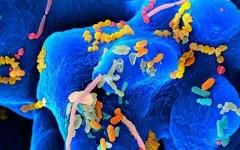(Press-News.org) Power converters are the little-known systems that make electricity so magical. They are what allow us to plug in our computers, lamps and televisions and turn them on in a snap. Converters transform the alternating current (AC) that comes out of wall sockets into the exact level of direct current (DC) that our electronics need. But they also tend to lose, in average, up to 20% of their energy in the process.
Power converters work by using power transistors - tiny semiconductor components designed to switch on and off and withstand high voltages. Designing novel power transistors to improve the converters' efficiency is the aim of the team of EPFL engineers. With their entirely new transistor design, based on the counterintuitive application of nanoscale structures for high voltage applications, much less heat is lost during the conversion process, making the transistors especially well-suited to high-power applications like electric vehicles and solar panels. Their findings have just been published in Nature Electronics.
The heat dissipation in converters is caused by the high electrical resistance, among other factors, which is the biggest challenge in power electronic devices. "We see examples of electric power losses every day, such as when the charger of your laptop heats up," says Elison Matioli, a coauthor of the paper and head of EPFL's POWERlab.
This becomes even more of a problem in high-power applications. "The higher the nominal voltage of semiconductor components, the greater the resistance," he adds. Power losses shorten the ranges of electric vehicles, for instance, and reduce the efficiency of renewable-energy systems.
Matioli, along with his PhD student Luca Nela and their team, have developed a transistor that can substantially reduce the resistance and cut the amount of heat dissipation in high-power systems. More specifically, it has less than half as much resistance as conventional transistors, while holding voltages of over 1,000 V. The EPFL technology incorporates two key innovations.
The first involves building several conductive channels into the component so as to distribute the flow of current - much like new lanes that are added to a highway to allow traffic to flow more smoothly and prevent traffic jams. "Our multi-channel design splits up the flow of current, reducing the resistance and overheating," says Nela.
The second innovation involves using nanowires made of gallium nitride, a semiconducting material ideal for power applications. Nanowires are already used in low-power chips, such as those in smartphones and laptops, not in high voltage applications. The POWERlab demonstrated nanowires with a diameter of 15 nm and a unique funnel-like structure enabling them to support high electric fields, and voltages of over 1,000 V without breaking down.
Thanks to the combination of these two innovations - the multi-channel design that allows more electrons to flow, and the funnel structure that enhances the nanowires' resistance - the transistors can provide greater conversion efficiencies in high-power systems. "The prototype we built using slanted nanowires performs twice as well as the best GaN power devices in the literature," says Matioli.
While the engineers' technology is still in the experimental phase, there shouldn't be any major obstacles to large-scale production. "Adding more channels is a fairly trivial matter, and the diameter of our nanowires is twice as big as the small transistors made by Intel," says Matioli.?The team has filed several patents for their invention.
Demand for chips that can perform efficiently at high voltages is set to boom as electric vehicles become more widely adopted, since more efficient chips translate directly into longer ranges. Several major manufacturers have expressed interest in teaming up with Matioli to further develop this technology.
INFORMATION:
University of Texas at Dallas researchers have discovered that a novel surface they developed to harvest water from the air encourages tiny water droplets to move spontaneously into larger droplets.
When researchers placed microdroplets of water on their liquid-lubricant surface, the microdroplets propelled themselves to climb, without external force, into larger droplets along an oily, ramp-shaped meniscus that forms from the lubricant around the larger droplets. The "coarsening droplet phenomenon" formed droplets large enough for harvesting.
"This meniscus-mediated climbing effect enabled rapid coalescence on hydrophilic ...
The evolving science of wisdom rests on the idea that wisdom's defined traits correspond to distinct regions of the brain, and that greater wisdom translates into greater happiness and life satisfaction while being less wise results in opposite, negative consequences.
Scientists have found in multiple studies that persons deemed to be wiser are less prone to feel lonely while those who are lonelier also tend to be less wise. In a new study, published in the March 25, 2021 issue of the journal Frontiers in Psychiatry, researchers at University of California San Diego School of Medicine take the connection between wisdom, loneliness ...
An analysis of adult human brain tissue reveals over 900 proteins tied to epilepsy. The brain disorder, estimated to afflict more than 3 million Americans, is mostly known for symptoms of hallucinations, dreamlike states, and uncontrolled, often disabling bodily seizures.
Led by researchers at NYU Grossman School of Medicine, the study examined molecular differences among the brains of 14 epilepsy patients and another group of 14 adults of similar age and gender who did not have the disease.
Study results showed that altered levels of brain proteins predominated in the hippocampus, a structure located deep inside ...
Researchers from Charité - Universitätsmedizin Berlin and the Francis Crick Institute have developed a mass spectrometry-based technique capable of measuring samples containing thousands of proteins within just a few minutes. It is faster and cheaper than a conventional blood count. To demonstrate the technique's potential, the researchers used blood plasma collected from COVID-19 patients. Using the new technology, they identified eleven previously unknown proteins which are markers of disease severity. The work has been published in Nature Biotechnology*.
Thousands of proteins are active inside the human body at any given time, providing its structure and enabling reactions which are essential to life. The body raises and lowers the activity ...
Expectant women are more likely to give birth early if they have high blood levels of a chemical used in flame retardants compared with those who have limited exposure, a new study finds.
These polybrominated diphenyl ethers (PBDEs) are used in the manufacture of furniture, carpeting, and other products to reduce flammability. Previous studies have found that the substances can leach into household dust and build up in the body where they may interfere with the thyroid, an organ that secretes brain-developing hormones. Childhood exposure to PBDEs has been linked to learning disabilities, autistic ...
Millions of years ago, aphid-like insects called whiteflies incorporated a portion of DNA from plants into their genome. A Chinese research team, publishing March 25th in the journal Cell, reveals that whiteflies use this stolen gene to degrade common toxins plants use to defend themselves against insects, allowing the whitefly to feed on the plants safely.
"This seems to be the first recorded example of the horizontal gene transfer of a functional gene from a plant into an insect," says co-author Ted Turlings (@FARCE_lab), a chemical ecologist and entomologist ...
Octopuses are known to sleep and to change color while they do it. Now, a study publishing March 25 in the journal iScience finds that these color changes are characteristic of two major alternating sleep states: an "active sleep" stage and a "quiet sleep" stage. The researchers say that the findings have implications for the evolution of sleep and might indicate that it's possible for octopuses to experience something akin to dreams.
Scientists used to think that only mammals and birds had two sleep states. More recently, it was shown that some reptiles also show non-REM and REM sleep. A REM-like sleep state was reported ...
More than half of the opioid tablets prescribed for patients who underwent orthopaedic or urologic procedures went unused in a new study by researchers at the Perelman School of Medicine at the University of Pennsylvania. Using an automated text messaging system that regularly checked in with patients on their pain and opioid use, the study also showed that most opioids are taken within the first few days following a procedure and may not be necessary to manage pain even just a week following a procedure. The study was published today in JAMA Network Open.
"Through simple text messaging we highlight a method which gives clinicians the information they need to reduce prescribing and manage ...
BOSTON - In the largest study of its kind to date, researchers at Massachusetts General Hospital, Brigham and Women's Hospital and the Ragon Institute of MGH, MIT and Harvard have found the new mRNA COVID-19 vaccines to be highly effective in producing antibodies against the SARS-CoV-2 virus in pregnant and lactating women. They also demonstrated the vaccines confer protective immunity to newborns through breastmilk and the placenta.
The study, published in the American Journal of Obstetrics and Gynecology (AJOG), looked at 131 women of reproductive age (84 pregnant, 31 lactating and 16 non-pregnant), ...
Chronic side effects among melanoma survivors after treatment with anti-PD-1 immunotherapies are more common than previously recognized, according to a study published March 25 in JAMA Oncology.
The chronic complications, which occurred in 43% of patients, affected the joints and endocrine system most commonly, and less often involved salivary glands, eyes, peripheral nerves and other organs. These complications may be long lasting, with only 14% of cases having been resolved at last follow-up. This finding contrasted with previously reported immunotherapy-related acute complications that affected visceral organs -- including the liver, colon, lungs and kidneys -- which were effectively treated with steroids. However, the vast ...



